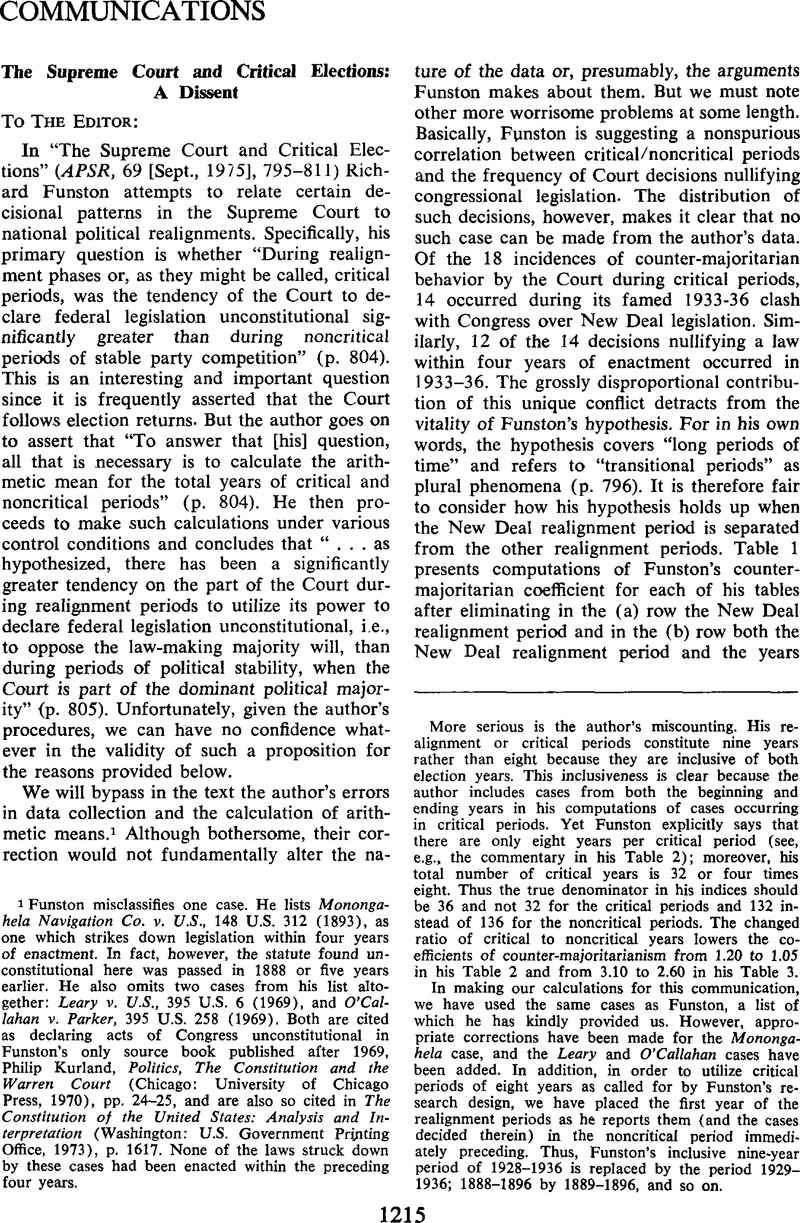Published online by Cambridge University Press: 01 August 2014

page 1215 note 1 Funston misclassifies one case. He lists Monongahela Navigation Co. v. U.S., 148 U.S. 312 (1893), as one which strikes down legislation within four years of enactment. In fact, however, the statute found unconstitutional here was passed in 1888 or five years earlier. He also omits two cases from his list altogether: Leary v. U.S., 395 U.S. 6 (1969), and O'Callahan v. Parker, 395 U.S. 258 (1969). Both are cited as declaring acts of Congress unconstitutional in Funston's only source book published after 1969, Kurland, Philip, Politics, The Constitution and the Warren Court (Chicago: University of Chicago Press, 1970), pp. 24–25Google Scholar, and are also so cited in The Constitution of the United States: Analysis and Interpretation (Washington: U.S. Government Printing Office, 1973), p. 1617Google Scholar. None of the laws struck down by these cases had been enacted within the preceding four years.
More serious is the author's miscounting. His realignment or critical periods constitute nine years rather than eight because they are inclusive of both election years. This inclusiveness is clear because the author includes cases from both the beginning and ending years in his computations of cases occurring in critical periods. Yet Funston explicitly says that there are only eight years per critical period (see, e.g., the commentary in his Table 2); moreover, his total number of critical years is 32 or four times eight. Thus the true denominator in his indices should be 36 and not 32 for the critical periods and 132 instead of 136 for the noncritical periods. The changed ratio of critical to noncritical years lowers the coefficients of counter-majoritarianism from 1.20 to 1.05 in his Table 2 and from 3.10 to 2.60 in his Table 3.
In making our calculations for this communication, we have used the same cases as Funston, a list of which he has kindly provided us. However, appropriate corrections have been made for the Monongahela case, and the Leary and O'Callahan cases have been added. In addition, in order to utilize critical periods of eight years as called for by Funston's research design, we have placed the first year of the realignment periods as he reports them (and the cases decided therein) in the noncritical period immediately preceding. Thus, Funston's inclusive nine-year period of 1928–1936 is replaced by the period 1929–1936; 1888–1896 by 1889–1896, and so on.
page 1216 note 2 See Frankfurter, Felix and Landis, James, The Business of the Supreme Court (New York: Macmillan, 1927), pp. 60 and 297Google Scholar, for data on the Court's cases in the periods cited. Opinion frequency from the New Deal era came directly from the U.S. Reports.
page 1217 note 3 In his Tables 4 and 5, Funston introduces and uses the concept of the lag period, but he combines the lag periods with the realignment period rather than making calculations for them separately. He describes two variations of the lag periods, neither of which coincide with our definition of it.
Comments
No Comments have been published for this article.